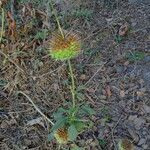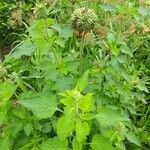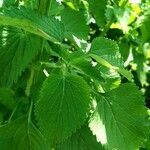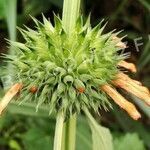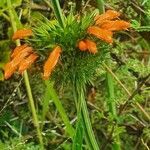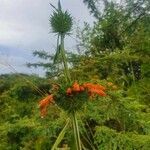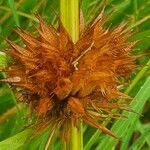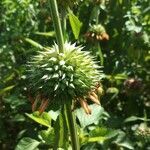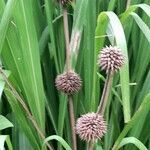Annual or short-lived perennial slender herb, 1-3 m tall, with easily uprooted c. 100 mm long taproot; stem branched at upper nodes only, green, shortly pubescent, deeply 4-furrowed apically; upper nodes with a tuft of 1-4 mm long hairs; internodes 20-150 mm long, in the inflorescence 70-280 mm. Leaves petiolate; blade broadly ovate, 50-200 x 40-150 mm, apex acuminate, base cuneate-attenuate to cordate-attenuate, margin deeply crenate with 25-51 teeth/leaf, green, pubescent and with colourless glands; petiole 30-80 mm long. Inflorescence of 2-5 spherical to cylindrical verticils 38-65 mm in diameter, with 20-28 verticil branches 2-16 mm long; pedicels 0.5-2 mm long; bracts 25-90 x 4-13 mm, linear; petiole 12-60 mm long; bracteoles stout, linear, 7-15 x 0.5-1.5 mm, acuminate. Calyx 17-25 mm long, 4-5.6 mm in diameter, bilabiate, bent forwards, shortly pubescent, basal half stiff, yellowish white, distal half flexible, green; calyx teeth straight, stiff, apiculate, the dorsal one 4-7 mm long, the others 1-3 mm long. Corolla 19-38 mm long, tube 9-20 mm long with three distinct rings of hairs inside the tube. Fresh pollen pale yellow. Nutlets 2.9-4.3 x 1.1-1.9 mm, surface not glossy, marmorated in grey and brown.
More
An erect herb. It is coarse and grows to 1-2 m high. It spreads 20-30 cm wide. It has 4 sided grooved stems. The lower leaves are oval and toothed. The upper leaves are opposite and sword shaped. They have teeth along the edge and are elongated to a narrow base. The flowers are red-orange tubes. They are in the axils of leaves. They form a round head of stiff spiny sepals.
It is a tropical plant. It grows in waste places. It can grow with moderate moisture or in fairly dry locations. It needs a well-drained soil. It is best in full sun but can tolerate shade. It grows in hot arid places with a marked dry season. It grows in sandy soils. It can grow between sea level and 2,000 m above sea level. It can grow in arid places. In Argentina it grows from sea level to 1,000 m above sea level. It suits hardiness zones 8-11. It is rare in Swaziland.
More
A pantropical weed, often found at roadsides and in abandoned cultivations at altitudes of up to 2,000 metres.
